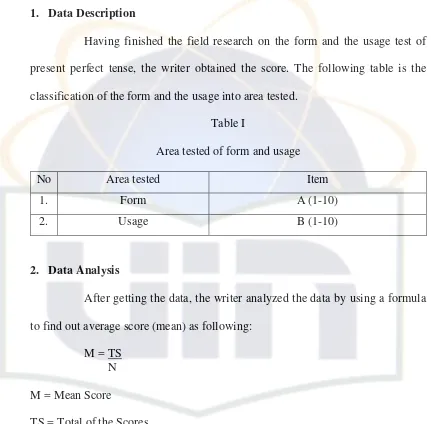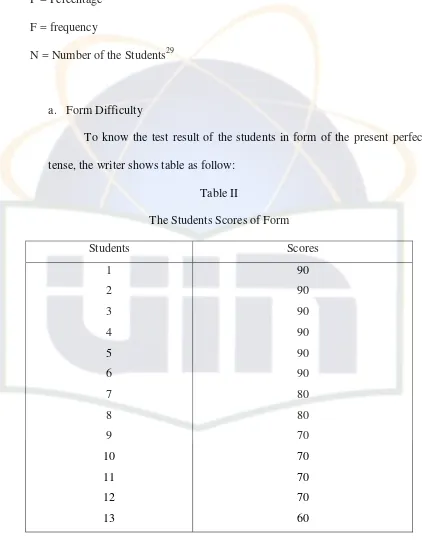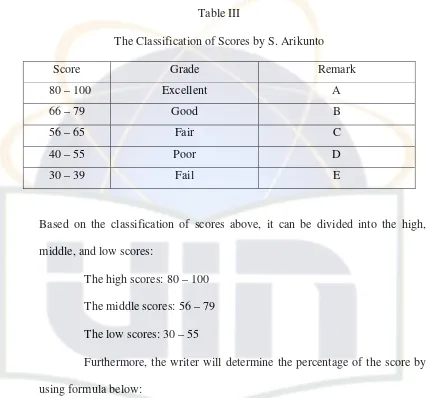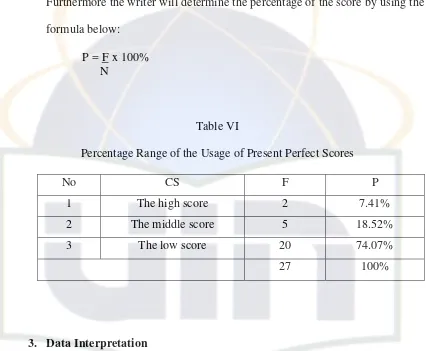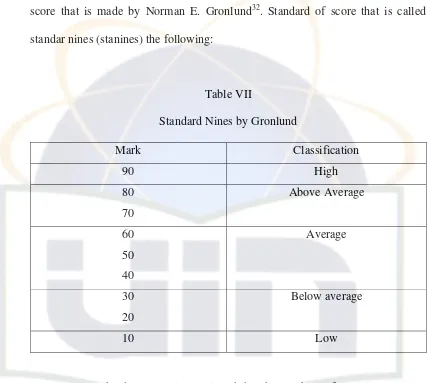SOME DIFFICULTIES FACED BY STUDENTS IN LEARNING
PRESENT PERFECT TENSE
(A Case Study at the Third Year of SMK YAPIA Pondok Aren)
A Skripsi
Presented to the Faculty of Tarbiyah and Teachers’ Training
In a Partial Fulfillment one of the Requirements for the Degree of Strata I (S1)
By
Sri Sulthan Auliya NIM: 102014023767
THE DEPARTMENT OF ENGLISH EDUCATION
THE FACULTY OF TARBIYAH AND TEACHERS’ TRAINING
STATE ISLAMIC UNIVERSITY
SYARIF HIDAYATULLAH
JAKARTA
SOME DIFFICULTIES FACED BY STUDENTS IN LEARNING
PRESENT PERFECT TENSE
(A Case Study at the Third Year of SMK YAPIA Pondok Aren)
A Skripsi
Presented to the Faculty of Tarbiyah and Teachers’ Training
In a Partial Fulfillment one of the Requirements for the Degree of Strata I (S1)
By
Sri Sulthan Auliya NIM: 102014023767
Approved by Advisor
Mas’ud Mada, MA. Nip. 150 012 951
THE DEPARTMENT OF ENGLISH EDUCATION
THE FACULTY OF TARBIYAH AND TEACHERS’ TRAINING
STATE ISLAMIC UNIVERSITY
SYARIF HIDAYATULLAH
JAKARTA
Legalization of Examination Committee
Paper Entitled “SOME DIFFICULTIES FACED BY STUDENTS IN LEARNING PRESENT PERFECT TENSE” (A Case Study at the Third Year of SMK YAPIA Pondok Aren) was examined at examination session of the Faculty of Tarbiyah and Teachers’ Training of State Islamic University Syarif Hidayatullah Jakarta on May 14, 2007. This paper has fulfilled the requirement for the Degree of Strata-1 (S1) at the English Department.
Jakarta, June 20, 2007
Examination Committee
The Head of Committee The Secretary of Committee
Prof. Dr. Dede Rosyada, MA Prof. Dr. H. Aziz Fahrurrozi, MA
NIP. 150 231 356 NIP. 150 202 343
Examiner I Examiner II
Drs. Nasrun Mahmud, M.Pd Drs. H. Munir Sonhaji, M.Ed
ACKNOWLEDGEMENT
In the name of Allah, the Beneficent, the Merciful
All praise be to Allah, the Lord of the Worlds, who has given bless, health and strength to the writer so he could complete this skripsi properly. Peace and blessing be upon our prophet Muhammad, his family, his companions and his followers.
This skripsi is presented to fulfill one of the requirements to obtain the Sarjana Degree at the English Education Department of the Faculty of Tarbiyah and Teachers’ Training Syarif Hidayatullah State Islamic University Jakarta.
On this great occasion, the writer would like to express greatest honor and his deepest gratitude to his beloved parents and his family, who always gives support, motivation and everything so that he could finish his study and also to Mas’ud Mada, MA, as the advisor, who has given his time, patience, guidance and valuable advices during completing his skripsi.
His deepest gratitude also goes to those who have helped him in finishing his work, among others:
1. Prof. Dr. H. Dede Rosyada, MA, the Dean of the Faculty of Tarbiyah and Teachers’ Training, State Islamic University Syarif Hidayatullah Jakarta.
2. Drs. Nasrun Mahmud, M.Pd, the Head of English Department and Miss. Nida Husna as the Secretary of English Department.
4. Drs. Hanafi, the Headmaster of SMK YAPIA Pondok Aren, who has permitted the writer to conduct the research at the school.
5. Drs. Amrullah, the English teacher of the twelfth grade, for the great cooperation. 6. The librarians of Tarbiyah and Teachers’ Training faculty, UIN, AMINEF and
ATMAJAYA who have given him the chance to overview the books and other references concerning with the topic he discussed in the research.
May Allah Bless them all, Amien. Finally, the writer realizes that this skripsi is far from being perfect; therefore, the writer would like to accept any constructive suggestion to make this skripsi better.
Jakarta, March 2007
TABLE OF CONTENTS
ACKNOWLEDGEMENT ………. i
TABLE OF CONTENTS ………. iii
CHAPTER I: INTRODUCTION ………. 1
A. Background of the Study ………. 1
B. Limitation of the Study ………. 2
C. Statement of the Problem ………. 3
D. Purpose of the study ………. 3
E. Method of the study ………. 3
F. Organization of the Writing ………. 4
CHAPTER II: THEORETICAL FRAMEWORK ……….. 5
A. Grammar ……….. 5
1. Definition of Grammar ……….. 5
2. English tense ……….. 6
B. Present Perfect Tense ……….. 8
1. The Meaning of Present Perfect Tense ……….. 8
2. The Form of Present Perfect Tense ……….. 8
CHAPTER III: RESEARCH METHODOLOGY AND FINDINGS ….. 15
A. Research Methodology ……….. 15
1. Method of the Research ……….. 15
2. Objective of the Research ……….. 15
3. Place and time ……….. 15
4. Population and Sample ……….. 16
5. Instrument of the research ……….. 16
B. Research Findings ……….. 17
1. Data Description ……….. 17
2. Data analysis ……….. 17
3. Data Interpretation ……….. 23
CHAPTER IV: CONCLUSION AND SUGGESTION ……….. 26
A. Conclusion ……….. 26
B. Suggestion ……….. 26
BIBLIOGRAPHY ……….. 27
CHAPTER I
INTRODUCTION
A. Background of the Study
In learning English, there are four skills (Listening, Speaking, Reading, and Writing) that should be mastered by students. Besides the four skills, Grammar also should be mastered by them. Grammar is needed even in communication. Without the proper knowledge of grammar the students will find many problems to build up the sentences and express their ideas for communication activities, but if they have good grammar, they will be confident in speaking English to other people. According to Penny Ur, “there is no doubt that a knowledge-implicit or explicit of grammatical rules is essential for the mastery of language: you cannot use words unless you know how they should put together”1.
Grammar is one of the language aspects which are taught to every language learner. It has an important role in understanding the English language. As said by Paul Robert that “grammar is a body of generalization about how people says things. In order to make generalizations, we must first agree on the meaning of terms for the things we wish to talk about”.2 Grammar accuracy is only part of communication to convey a message, where grammar is merely a tool.
1
Penny Ur, Grammar Practice Activities, (Cambridge University Press, 1998), p. 4
2
In this skripsi, the writer will not discuss grammar in general. He will write about tense. Tense is one of discussions of grammar. According to Richard Veit, “Tense is frequently described as the property that relates to the time a verb’s action is performed”3. Some grammarians said that English has a great variety of tenses. This is one of reasons why the Indonesian students have difficulties in understanding tenses, because there are no tenses in Indonesian language. Present perfect tense is one tense that should be mastered by students, but it sometimes makes them confused. The effect is they cannot use and understand properly the present perfect tense.
Even though the twelfth grade students of Senior High School have learned it, they still find difficulty in learning present perfect tense, especially in using forms and usages.
From that background, he is interested in writing about the problems in grammar test on Present Perfect Tense to the third year students of SMK YAPIA Pondok Aren.
B. Limitation of the Study
In this skripsi, the writer discusses the students’ difficulty faced by the Senior High School at the third year of SMK YAPIA Pondok Aren in learning grammar. The writer restricts in present perfect tense, either the forms or the usages.
3
C. Statement of the Problem
Based on the statement above, the writer formulates the problem as follows: what difficulty do the students at SMK YAPIA Pondok Aren get in learning present perfect tense?
D. Purpose of the Study
The purpose of the study is to find out the difficulties in learning grammar, especially present perfect tense of the students at the third year of SMK YAPIA Pondok Aren in terms of forms or the usages.
In addition, the writer expects that this skripsi will be useful for himself and other people in general.
E. Method of the Study
In doing the research, the writer uses two kinds of research; field research and library research. In the library research the writer reads some books, papers, internet, and other references concerning to the topic he discussed. He also visited some libraries such as UIN library, AMINEF library, and ATMAJAYA library.
F. Organization of the Writing
Organization of this skripsi is to facilitate the discussion of the problem and help the readers understand what they read. The writer divides this skripsi into four chapters.
Chapter One is introduction, containing background of the study, limitation of the study, statement of the problem, purpose of the study, method of the study, and organization of the writing.
Chapter Two is theoretical framework. This chapter discusses grammar, definition of grammar and English tense. And then present perfect tense, the meaning of the present perfect tense, the form of present perfect tense, and the usage of present perfect tense
Chapter Three is research methodology and finding. The research methodology is divided into five items. They are method of the research, objective of the research, time and place, population and sample, instrument of the research. And then research finding. It is divided into three items. They are data description, data analysis, and data interpretation.
CHAPTER II
THEORETICAL FRAMEWORK
A. Grammar
1. Definition of Grammar
The knowledge of grammar is very important to what we want to say and interpreting correctly. It also enables us to make statements about how to use our language. According to J. Donald Bowen in his book “Grammar is the rules by which we put together meaningful words and parts of words of a language to communicate messages that are comprehensible”.4
Richard (1985) wrote “Grammar is description of the structure of a language and the way in which linguistic units such as words and phrases are combined to produce sentence in the language”.5
In grammar there are three interrelated dimension: form, meaning, and use. As Nunan said “Grammar is the study of how syntax (form), semantics (meanings), and pragmatics (use) work together to enable individuals to communicate through language”.6
4
J. Donald Bowen, TESOL Techniques & Procedures, (Cambridge: New Burry Publisher, 1992), p. 161
5
David Nunan, Second Language Teaching and learning, (New York: Heinle & Heinle Publisher, 1999), p. 97
6
From those definitions, grammar can be defined as the way words put together to make correct sentences. Thus, in English we are students is grammatical, while we a students and we is a students are not. Besides that, grammar can teach us how to speak, to read, and to write correctly.7 So, people can build up sentences and express their ideas for communication activities, and also will feel confident to use it in communication activities.
2. English tense
The word “tense” derived ultimately from the Latin word “tempus” meaning “time”.8 Tense commonly refers to the time of the situation which relates to the situation of the utterance or at the moment of speaking.
In talking about tense, it is not only focused on the time of the situation that is being described, but also “English marks tense by changes in the verb form”.9 And some grammarians believe that tense must always be shown by the actual of the verb, and in many language present, past, and future are indicates by changes in the verb form”.10 Almost all verbs can show the difference between the present, past, and future time by change in the verb form. From this, tense can be also defined as “a way
7
A. J. Thomson and A. V. Martinet, A Practical English Grammar, (Oxford: Oxford University Press, 1986), 4th ed., p. 1
8
Jhon Lyons, Linguistics Semantic an Introduction, (Cambridge: Cambridge University Press, 1995), p. 312
9
www.humnet. ucla. Edu/humnet/aflag/aspect.html.hausa_online_grammar/tenses/tense.html.
10
of languages to express the time at which on event described by a sentence occurs. In English, this is a property of a verb form”.11 Geoffrey Leech and Jan Svartvik state that by tense we understand the correspondence between the form of the verb and our concept of time (past, present, or future)”.12
From the morphological’s point of view, there are, as is well known, only two tenses in English. These tense are “present” and “past”.13
The present tense: how are you today?
The past tense: fine thanks, but yesterday I felt awful.
All other tense forms such as present progressive, perfect, tense are verb phrases containing one or more auxiliaries. They are constructed by combining a tense (present, past) with an aspect (progressive and perfect).
The progressive aspect: how are you feeling today? The perfect aspect: I’ve never felt better, thanks.
From those statements, tense can be defined clearly as Joyce M. Hawkins said in the oxford paperback dictionary that tense is any of the forms of a verb that indicate the time of action.14
11
http: // www. Free. Encyclopedian.com.
12
Geoffrey Leech and Jan Svartvik, A Communicative Grammar of English, (London: Pearson Education Limited, 2002), 3rd ed., p. 415
13
Paul Roberts, Understanding Grammar, (New York: Happer & Row Publisher, 1954), p. 155
14
B. Present Perfect tense
1. The Meaning of the Present Perfect Tense
Present perfect tense, in Oxford Learner’s Pocket Dictionary defined as verb form which expresses an action done in a time period up to the present, formed in English with have/has and past participle.15
Michael Agnes said, “present perfect tense indicates an action as completed or a state as having ended at the time of speaking but not any definite time in the past”.16
From two definitions above, the writer concludes that present perfect tense can be defined as an action or events occurred in the past which are completely finished but still have connection to the present or future.
2. The Form of the Present Perfect Tense
In a Practical English Grammar, A. J. Thomson and A. V. Martinet said, “The present perfect tense is formed with the present tense of have + past participle”.17 They also said, “The negative is formed by adding not to the auxiliary, the interrogative is formed by inverting the auxiliary and subject”.18
15
Oxford Learner’s Pocket Dictionary, (New York: Oxford University Press, 2000), new ed., p. 338
16
According to Raymond Murphy, “the present perfect tense is formed with have/has +the past participle”.19
Therefore, the writer formulates it as follows: a. Affirmative
S + have/has + V3 Examples:
I have worked You have been ill
We have gone to Lampung They have eaten breakfast He has been busy
She has arrived
b. Negative
S + have/has + not + V3 Examples:
I have not worked You have not been ill
We have not gone to Lampung They have not eaten breakfast
19
He has not been busy She has not arrived
c. Interrogative
1. The positive form Have/has + S + V3 Examples:
Have I worked? Have you been ill?
Have we gone to Lampung? Have they eaten breakfast? Has he been busy?
Has she arrived? 2. The negative form
a. Have/has + S + Not + V3 Examples:
Have I not worked? Have you not been ill?
Have we not gone to Lampung? Have they not eaten breakfast? Has he not been busy?
b. Haven’t/hasn’t + S + V3 (contraction). Examples:
Haven’t I worked? Haven’t you been ill?
Haven’t we gone to Lampung? Haven’t they eaten breakfast? Hasn’t he been busy?
Hasn’t she arrived?
3. The Usage of the Present Perfect Tense
Betty Schrampfer Azar said “the present perfect expresses the idea that something happened (or never happened) before now, at an unspecific time in the past, the exact time it is not important”.20 She also said “the present perfect also expresses the repetition of an activity before now”.21
Michael Swan said “when we want to talk about actions or situations, which started in the past and have continued up to the present, we often use the present perfect to show the connection between past and present”.22
In a Practical English grammar, A. J. Thomson and A. V. Martinet state that this tense may be said to be sort of mixture of present and past, it is always implies a
20
Betty Schrampfer Azar, Understanding and Using English Grammar, (New Jersey: Prentice-Hall, Inc., 1989), 2nd ed., p. 29
21
Ibid
22
strong connection with the present and is chiefly used in conversation, letter, newspaper, and radio reports”.23
Ruth Pierson and Susan Vik also have their own opinion, they said “the present perfect tense can express actions that (a) are finished, but do not occur with a specific past time expression, (b) started in the past, continued to the present, and are still happening now”.24
Raymond Murphy said “when we talk about a period of time that continues from the past until now, we use the present perfect”.25
From those statements above, the writer concludes several usage of present perfect tense as follows:
a. To express past action whose time is not given and not definite. Examples:
I have read the newspaper but I don’t understand them. Ana has never gone to Africa.
b. To express that an action or event has been repeated. Examples:
We have watched that movie three times She has visited Bandung several times
23
A. J. Thomson and A. V. Martinet, Opcit, p. 166
24
Ruth Pierson and Susan Vik, Making Sense in English Grammar in Context, (Boston: Addison-Wesley Publishing Company, Inc., 1987), p. 152
25
c. To express the action finished in the past and still progressing now. Examples:
I have lived in Indonesia since 1983 (I still live in Indonesia now) He has been in the army for two years (he is still in the army) d. To refer to the present result of an activity or experience in the past.
Examples:
I have come to school without my glasses (so now I can’t see to read) She has finished her works (so now she can sit back and rest)
Some adverbs that often used in present perfect tense. 1. Just: to indicate completed activities in the immediate past.26
Examples:
George has just gone out (he went out a moment ago)
We have just finished breakfast (we finished breakfast a few minutes ago) 2. Already: to say something happened sooner than expected.27
Examples:
‘Don’t forget to post the letter, will you?’ ‘I’ve already posted it’ ‘What time is Mark leaving?’ ‘He’s already gone’
26
A. S. Hornby, Guide to Patterns and Usages in English, (Oxford: Oxford University Press, 1975), 2nd ed., p. 90
27
3. Yet: to show that speaker is expecting something to happen.28 Use yet only in questions and negative sentences.
Examples:
Has it stopped raining yet?
I’ve written the letter but I haven’t posted it yet. 4. Lately
Examples:
I’ve been very busy lately She hasn’t been well lately. 5. Recently
Examples:
I’ve seen Mark recently.
There have been a lot of changes recently.
28
CHAPTER III
RESEARCH METHODOLOGY AND FINDINGS
A. Research Methodology
1. Method of the Research
In this research, the writer did both the library research and field research. In the library research the writer reads some books, papers, internet, and other references concerning with the topic he discussed. He also visited some libraries such as UIN library, AMINEF library, and ATMAJAYA library.
In the field research, to make the writer easier in analyzing the data he did the observation and gave the test to the third year students of SMK YAPIA Pondok Aren.
2. Objective of the Research
To find out what difficulty do they have in learning present perfect tense in terms of the form or the usage.
3. Place and Time
The research was carried on January 2007. It was begun by observation on Saturday 27. And then on Wednesday 31, he gave test about present perfect tense.
4. Population and Sample
In this research the writer took the population of the third year students of SMK YAPIA Pondok Aren consisting of 2 classes (III Akuntansi and III Sekretaris). The total population is about 61 students from the two classes, 30 for III Akuntansi class and 31 for III Sekretaris class.
In sample, the writer did not take all the population. He took one class as a sample that is in the third class of 27 students when he was doing the test.
5. Instrument of the Research
To get the data, the writer gave a test to. The type of the test is essay. It is focused on present perfect tense. This test consists of 20 items which are divided into two parts. The first is form (10 items) and the second is usage (10 items). So, every correct item gets 5 points. The instrument of the test can be seen in appendix.
B. Research Findings
1. Data Description
Having finished the field research on the form and the usage test of present perfect tense, the writer obtained the score. The following table is the classification of the form and the usage into area tested.
Table I
Area tested of form and usage
No Area tested Item
1. Form A (1-10)
2. Usage B (1-10)
2. Data Analysis
After getting the data, the writer analyzed the data by using a formula to find out average score (mean) as following:
M = TS N M = Mean Score
TS = Total of the Scores N = Number of the Students
Besides the formula above, the writer also used the percentage the test formula, as follow:
P = Percentage F = frequency
N = Number of the Students29
a. Form Difficulty
To know the test result of the students in form of the present perfect tense, the writer shows table as follow:
Table II
The Students Scores of Form
Students Scores
14
The writer uses formula to find the mean, as follow: M = TS
N = 1550 27 = 57.4
Suharsimi in her book writes the classification of scores as follow30: Table III
The Classification of Scores by S. Arikunto
Score Grade Remark
80 – 100 Excellent A
66 – 79 Good B
56 – 65 Fair C
40 – 55 Poor D
30 – 39 Fail E
Based on the classification of scores above, it can be divided into the high, middle, and low scores:
The high scores: 80 – 100 The middle scores: 56 – 79 The low scores: 30 – 55
Furthermore, the writer will determine the percentage of the score by using formula below:
P = F x 100%
N
P = Percentage F = Frequency
N = Number of Students
30
Table IV
Percentage Range of the Form of Present Perfect Scores
No CS F P
To know the test result of the students test in usage of present perfect tense, the writer shows the tables as follow:
Table V
The Students Scores of Usages
7
To find the mean score, the writer uses formula: M = TS
= 41.5
According to the data above, it is found that the mean score is 41.5
Furthermore the writer will determine the percentage of the score by using the formula below:
P = F x 100% N
Table VI
Percentage Range of the Usage of Present Perfect Scores
No CS F P
1 The high score 2 7.41%
2 The middle score 5 18.52%
3 The low score 20 74.07%
27 100%
3. Data Interpretation
The next step that the writer did is to interpret and discuss the data, the interpretation of data cannot be separated by analyzing the data as Julian Stanley (1964: 319) quoted that “for analysis is worthless without interpretation, and interpretation is impossible without analysis”.31
31
Before interpreting and discussing the data, the writer uses standard of score that is made by Norman E. Gronlund32. Standard of score that is called standar nines (stanines) the following:
Table VII
Standard Nines by Gronlund
Mark Classification
On the data analysis mentioned that the numbers of participant are 27. The mean score in using the form of present perfect tense is 57.4 and the mean scores in using the understanding the usage of present perfect tense is 41.5. Based on Gronlund standard nines (stanines), it is average.
Then the writer would like to present the classification of the students’ scores, as the table below
32
Table VIII
The Classification of the Students’ Scores
Total percentage of the students’ scores No CS
FP test UP test
1 The high score 29.63% 7.41%
2 The middle score 22.22% 18.52%
3 The low score 48.15% 74.07%
CS = the classification of the scores FP = the form of present perfect tense UP = the usage of present perfect tense
The comparative percentage between the high, the middle, and the low scores of the students in answering the question about the form and the understanding usage of present perfect tense are:
The form: 29.63%; 22.22%; 48.15%. It means that many students got low scores, it is 48.15%.
CHAPTER IV
CONCLUSION AND SUGGESTION
A. Conclusion
Based on the data interpretation above, the writer makes conclusion that the third year students of SMK YAPIA Pondok Aren have difficulty in learning the usage of present perfect tense. It can be known from the explanation above that there are 48.15 % students who still get difficulty in the form of present perfect tense, and there are 74.07 % students who still get difficulty in the usage of present perfect tense.
B. Suggestion
There are some suggestions that can be given in relation to the writer’s conclusion. The suggestions are as follow:
1. It is hoped that the teacher can give more attention in teaching present perfect tense, especially in the usage.
2. The English teacher should choose the best method to teach tenses, especially present perfect tense.
3. It is hoped that the teacher should present the usage of present perfect tense in a clearly way in order to the student understand them easily.
BIBLIOGRAPHY
Arikunto, Suharsimi, Dr., Dasar-dasar Evaluasi Pendidikan, Jakarta: Bumi Aksara, 1995, cet. ke-11
Azar, Betty Schrampfer, Understanding and Using English Grammar, New Jersey: Prentice-Hall, Inc., 1989
Azra, Azyumardi, Prof. Dr., Pedoman Penulisan Skripsi, Tesis, dan Disertasi, Jakarta: UIN Jakarta Press, 2002
Hewings, Martin, Advanced Grammar in Use, Cambridge: Cambridge University Press, 2005, 2nd ed.
Hornby, A.S., Guide to Patterns and Usage in English, Oxford: Oxford University Press, 1975
http://www.Free.Encyclopedian.com
Krohn, Robert, English Sentence Structure, Michigan: The University of Michigan Press, 1967
Leech, Geoffrey and Jan Svartvik, A Communicative Grammar of English, London: Pearson Education, 2002, 3rd ed.
Murphy, Raymond, English Grammar in Use, Cambridge: Cambridge University Press, 1994, 2nd ed.
Nunan, David, Second Language Teaching and Learning, New York: Heinle & Heinle Publisher, 1999
Pollock, Carrel Washington, Communicative What You Mean, New Jersey: Prentice-Hall, Inc., 1982
Roberts, Paul, Understanding Grammar, New York: Harper & Row Publisher, 1954 Sudijono, Anas, Drs., Pengantar Statistik Pendidikan, Jakarta: PT. Raja Grafindo
Persada, 2001, cet. ke-11
Thomson, A.J. and A.V. Martinet, A Practical English Grammar, Oxford: Oxford University Press, 1980, 3rd ed.
Veit, Richard, Discovering English Grammar, Boston: Houghton Mifflin Company, 1986
Appendix I
TEST INSTRUMENT
A. Write the correct form of present perfect tense of the verb in parentheses in each sentence!
1. I _____________ Adam for ten years. (know) 2. John _____________the letter yet. (post, not)
3. In my whole life time, I _____________ snow. (never, seen)
4. Up to now, Professor Andrew _____________ our class three tests. (give) 5. The students ______________ their exercises. (finish, just)
6. Carmen ________________ here since 1980. (be)
7. So far this week, I _______________ two tests and a quiz. (have) 8. My sister __________________ me twice for today. (phone) 9. My family and I ________________ to London. (go, not) 10.The plane _________________ the airport. (already, leave)
B. Supply the correct present perfect or simple present of the verbs in bracket! 1. Mr. Smith ________________ English for many years. (teach)
2. The water ________________ of hydrogen and oxygen. (consist) 3. They _________________ out. (go, just)
4. My family and I ________________ since 1980. (be) 5. I _________________ well today. (feel, not)
6. I _________________ any parties since I came here. (attend, not) 7. The world _________________ round. (be)
8. He ________________ here before. (be, never) 9. The sun ______________ during the day. (shine)
Appendix II
ANSWER KEY
A.
1. Have known 2. Has not posted 3. Have never seen 4. Has given
5. Have just finished 6. Has been
7. Have had 8. Has phoned 9. Have not gone 10.Has already left
B.
1. Has taught 2. Consists 3. Have just gone 4. Have been 5. Do not feel 6. Have not attended 7. Is
8. Has never been 9. Shines
